Electric convectors are often used as main or additional heating devices, especially in non-gas-free settlements. Using these devices, you can set the desired temperature in your house, apartment or country house without much expense or hassle. What you need to consider when choosing an electric convector will be discussed in this article.
Electric convector heater for heating: how to choose a good unit
Heat sources
To heat a living space, a person uses different heat sources. The most common was hot water circulating in a closed kennel from pipes laid throughout the house.
But the water still needs to be heated before being fed into the pipes. For this purpose, centralized heat supply is used in multi-storey buildings.
In this case, there is a separate boiler plant, where combustion of gas or coal is used for heating.
In private homes, autonomous gas heating is more often used, where a small gas boiler is used to heat water, providing heat only to the house in which it is installed.
It’s just that with centralized heating, certain deadlines are set for providing heat to the house, and the heat supply itself wants to leave the best.
In the private sector, there are times when the house is cool and you don’t want to start the boiler.
In this case, electric heaters come to the rescue. Although they consume a significant amount of electricity, since they have significant power, they are able to quickly heat any room in the house.
There are a large number of types of electric heaters, from simple spiral heaters, popularly nicknamed “goats,” to modern infrared and convector heaters.
The latter are becoming increasingly popular these days.

Convector heater design
The electric convector is externally made in the form of a rectangular structure of small thickness, with a horizontally oriented grille on top of the front side, and another similar grille, but at the bottom of the back side.
The heater control unit is located at the end of the top or side part.

Inside the convector body there is a heating element with a diffuser, a control board and a temperature sensor.
Moreover, the heating element and diffuser are located in the lower part, and the board is located at the top. This is the whole filling of such a heater.
The control board additionally includes a thermostat that allows you to maintain the temperature in the room, as well as a fuse that controls the operating temperature of the device and provides emergency shutdown in case of overheating.
Designs of convector heaters.
Convectors use several heaters of different designs.
The simplest are needle-type heating elements. They have a plate on which a nickel thread is attached in the form of loops.
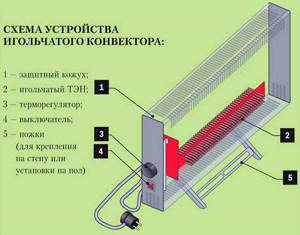
There are also tubular heating elements in which the heating element is located inside the tube.

The best are monolithic heaters that use a sealed tube filled with magnesite.

The diffuser consists of aluminum plates installed along the entire length of the heating element tube. Its task is to ensure better heat transfer by increasing the area of the heating element.
The temperature sensor is located near the bottom grill. The sensor itself is very sensitive and is capable of detecting a temperature change of even 0.1 degrees. WITH.
Taking care of your health
Devices produced by Electrolux are absolutely safe for health. Of all the variety on the market, convectors of this brand invariably make it onto the list of leaders. Let us list the characteristic features of its models:
- They have a set of filters for air purification. The antistatic filter absorbs the largest dust particles, the carbon filter destroys cigarette smoke and other unpleasant odors, and the catechin filter safely destroys microbes contained in the air.
- They have a memory function to maintain the set temperature even during a long power outage.
- Suitable for both wall and floor installation. The wall mounts contain special limiters, the use of which will prevent the convector from accidentally falling.
- They have 2 operating modes: maximum and medium power.
Electrolux heating equipment is designed not only to warm up the house, but also for sanitary air purification. In the off-season, such a convector will protect you from colds and allow you to maintain a comfortable temperature.
Silent convector Ballu with inverter
Sleek and economical, Ballu features virtually silent operation. Its heating element can operate in any of 2 power modes without burning oxygen. Some models from this manufacturer have a monolithic structure. Just a few hours of operation of the convector is enough for a qualitative change in the air and its ionization.
This device is easy to use and equipped with only the most necessary functions, including:
- automatic triggering of the sensor when overheating;
- remembering user settings;
- operation in 2 power modes;
- key locking to protect against unintentional activation;
- waterproof housing;
- automatic shutdown when tipping over.
Devices for maximum heat transfer
The fashionable Zanussi convector will be able to warm up the room to the correct temperature in a short time. When creating it, engineers used new technologies that made it possible to increase the volume of air taken in by the device. In addition, the convector is characterized by absolutely silent operation due to the presence of a monolithic heating element.
The key feature of such equipment is ultra-fast heating of the air in the room.
Also of some interest are devices from the manufacturer Timberk. They are equipped with a sensor that signals that the equipment will turn off in an emergency situation, for example, if it falls. The one-piece housing contains a high-precision thermostat that protects against overheating.
Principle of operation
The operation of this heater is based on the ability of air to rise upward when heated.
In a convector, this property is implemented as follows: cold air located at the bottom of the room enters the convector through the lower grille.
Passing through the heating element with a diffuser, the air heats up and rises upward, where it exits through the upper grille.

Hot air rushes upward and displaces cooler air, which falls down and enters the convector.
In this way, air is circulated through the convector, which ensures constant heating of the air, and as a result, the temperature in the room.
Additionally, heat exchange is carried out by the convector body itself. The air, rising up inside the housing, heats it, and it subsequently gives off heat to the external environment.
This design is good because even with maximum heating, the walls of the case do not heat up too much, which ensures safety.
The temperature to which the air should be heated when passing through the convector heater is set on the control unit.
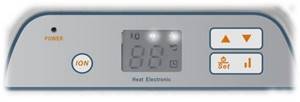
Design and principle of operation of a heating convector

Structurally, an electric convector consists of a metal body (most often aluminum), a closed-type heating element, a thermostat, sensors, one of which measures the outside temperature, and the second is responsible for turning off the device when it overheats.
Due to the high thermal conductivity of metal parts, the efficiency of the device itself increases greatly, which allows you to quickly heat the room.
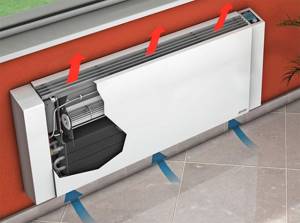
Three main types of heating element:
- needle;
- tubular;
- monolithic.
The principle of operation is understood by any student who has attended physics classes. Through the holes at the bottom of the housing, air enters the convector, touching the heating element , it heats up and rushes upward, thereby creating circulation and continuous movement of cold air masses through the heating element.
Advantages and disadvantages
Electric convectors have enough advantages. Its first and most important advantage is high efficiency; the convector provides this indicator at 95%.
In addition, positive qualities also include:
- Easy to install and use. All you need to do is place it next to the outlet, connect it to it and set the temperature;
- The design of such a convector is very simple, which ensures high reliability. The average service life of a convector is approximately 15 years. At the same time, it requires minimal maintenance - periodic cleaning of the device from dust;
- The presence of a thermostat in the design ensures automatic maintenance of the temperature in the room, without human intervention. When the desired temperature in the room is reached, it turns off. As soon as the temperature drops, the convector turns on. Moreover, the convector is guided by the temperature in the lower part of the room, that is, by the cold air. Therefore, the temperature sensor is located at the bottom of the convector;
- The design of such a convector has no moving parts, which ensures silent operation. The only source of noise can be a thermostat, made in the form of a mechanical relay. When activated, such a thermostat will create a clicking sound when the contacts close. Electronic thermostats do not make any sounds;
- These heating devices begin to provide heat to the room almost immediately after being plugged in, and are able to quickly heat the air in the room;
- Safety of use. Even at maximum performance, the heater body, which also participates in heat exchange, does not heat up to such a temperature that can cause a burn to a person. A fuse protects the device from overheating.
Flaws.
However, convector heaters also have disadvantages. Although they are few and far between, they exist.
So, the disadvantages of convectors include:
- Significant energy consumption. Although this indicator largely depends on the thermal insulation of the room. With strong heat losses due to drafts, poor insulation of walls and windows, energy consumption will be high, but if thermal insulation is at the proper level, energy consumption will not be particularly high;
- It will not be economically feasible to heat large rooms with convectors. They are more suitable for local heating. That is, they are best used either in small rooms or as a supplement to centralized heating;
- Convector heaters, although they do not heat the air to significant temperatures, still dry it out somewhat. Therefore, when using such devices, it is better to worry about air humidification in advance;
- Even without moving parts, the convector is capable of spreading dust throughout the room. It does this because the air circulates during its operation due to heating, and therefore moves small dust particles.
We recommend reading - how to choose electric heating boilers.
Protective functions
Almost all modern convectors are equipped with built-in overheating protection. It is triggered when the temperature controller fails or when the convection openings in the housing are closed, for example, when drying clothes on a convector. The protection turns off the heater when it reaches a temperature that is dangerous for the insulation of the device or people.

Location of the protective overheating sensor and convector design
Protection against splashing water is provided by the design of the housing, the size and location of the holes. It can be determined by the IP index indicated in the passport. For a bathroom or kitchen, the minimum value of this index should be 24.

Classification of devices according to IP indicator
Many floor-standing and universal convector models are also equipped with tip-over protection. If the convector falls and changes its position to horizontal, the protection ensures quick shutdown of the heater.
Like all other household appliances, convectors must have a degree of protection against electric shock of at least “2”. This means that the power cord and plug of the device have a built-in ground, so the metal case does not need a separate ground.
Note! The convector only needs to be connected to a socket with a grounding conductor.

How to choose an electric heating convector

Electric convector Scoole SC HT HL1 1000 W
Types of convector heaters
Structurally, all convector heaters are very similar, but several types are produced - wall-mounted, free-standing, floor-mounted and for rooms with high humidity.
They can be divided into high ones - with a height of up to 650 mm, and low ones - up to 200 mm.

Wall-mounted and free-standing are classified as high. The difference between them comes down to the fact that wall-mounted ones are equipped with lugs for mounting on the wall, making them stationary and providing heating only for the room where they are installed.

Free-standing - they have legs with wheels at the bottom, which allows them to be moved if necessary, providing warmth in different rooms.
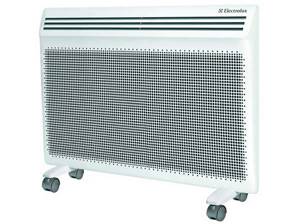
A feature of this type of heaters is the high heating of the heating element, which, in combination with a high body, ensures high air circulation, which ensures their high thermal efficiency.
Floor heaters are made slightly differently, although their design is identical. They are not high, they are also called “plinth”.
But their width is much greater. Some models reach a width of 3000 mm.
Essentially, this is the same convector, but located horizontally. The large length and width, while its low location allows the heating elements to heat up less to achieve the required temperature, since they heat the lower layers of air more efficiently.
I often install such heaters under window openings.

The inconvenience of using floor heaters comes down to the same width. They take up more floor space, which leads to the possibility of frequent kicking.
Although some home owners, during construction, pre-allocate niches in the floor for installing such heaters, and then protect them with a grille.
Underfloor electric heating convector ESK series.

The types of convectors described above have one feature - they cannot be used in rooms with high humidity levels.
However, special versions of convectors are produced - waterproof. In such heaters, all internal elements are protected from moisture and can be used in any room.

The principle of the device
If we talk about design features, then the wall convector includes a housing, a heating element (closed type), a thermostat and temperature sensors and switching off the device in case of overheating. Let's look at the elements of the device in more detail.
Prices for electric convector
electric convector
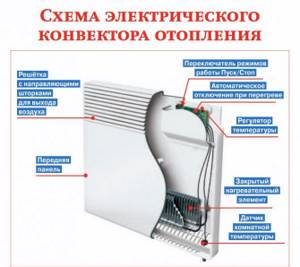
Convector device diagram
First of all, the body itself is important. Usually this is a box made of thin aluminum, steel or high-strength plastic (less commonly). The light weight of the housing allows you to install the device on any wall, even with large dimensions of the convector. Such a housing is similar to a vertical pipe, where the temperatures at the inlet and outlet differ significantly. This contributes to high draft, and therefore strong convection air flow.
There are brackets on the back of the device panel that allow you to easily hang the convector on the wall.

Bonjour CEG FN-meca 500 W
Interesting: some devices may be equipped with additional wheels. This makes them not only convenient to place, but also very mobile.
So, at the bottom of the convector there are inlets where cold air enters. Depending on the model, the lower part can have either windows or one long opening. There is also a temperature sensor at the entrance. It is responsible for turning the heating element on and off: when the desired temperature is reached, the device will stop heating the air. And vice versa, as soon as the incoming air masses are recognized by the sensor as not warm enough, the heating element is turned on and the convector operation continues. This is very convenient and significantly saves electricity consumption.

Cold air enters the device through the lower openings, and warm air exits from the upper ones.
The cold air that gets inside becomes warm due to the operation of the heating element. There may be several of these in a convector. The heating elements are different in different models: they can be spirals, modules - anything.
There are exit holes at the top of the device. This is where the heated air is directed, and from there it enters the room. Some convectors are equipped with small curtains, with which you can change the direction of warm air masses.
The device is controlled as standard: by a switch. Each is equipped with indicators and a thermostat, and some have various additional functions.
Expert opinion: Masalsky A.V.
Editor of the “construction” category on the Stroyday.ru portal. Specialist in engineering systems and drainage.
As a rule, there is another very important “helper” inside the convector. This is a temperature sensor that protects the device from unplanned strong heating. This protection system is very effective: if the temperature rises excessively, the power to the convector is turned off.
Important: situations like this are not uncommon. Often users themselves contribute to the disruption of air mass circulation. Such interference includes various objects that interfere with the operation of the device (for example, some kind of thing), or the accumulation of dust.

This principle of constructing a wall-mounted convector is classic; it is typical for almost any similar device. There are models with a different design and more equipment.
Video - Operating principle of an electric convector
Choosing a convector heater
And the design of the convector seems to be clear, but choosing the right heating device is not so easy, since there are a large number of factors that influence the correct choice.
One of the factors that should be considered when selecting a convector is its type.
The most common are wall convectors. They are able to provide a good amount of heat to the room, since they are located directly on the walls.
They are often placed under window openings. This allows you to create a thermal curtain near potential sources of cold air when using a convector. But they are stationary.
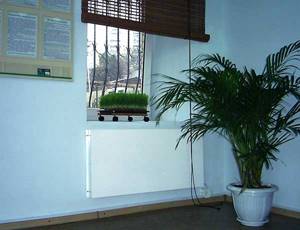
If you need to create comfortable conditions in different rooms, then it is better to purchase a free-standing convector equipped with wheels for movement. It is convenient to drag such a convector from room to room; the only condition is that there is an outlet in the room.

Wall-mounted and free-standing convectors are often used as additional heating, although there is heating in the house that is fully provided by these devices.
Floor convectors are often used as the main heating in the house, and niches for installation are prepared for them at the planning stage of the house.
Convector control
The second factor that is taken into account when choosing a convector is the type of control unit and thermostat. They are divided into mechanical and electronic.
The mechanical control unit is not a mechanical control unit; it simply includes a thermostat in the form of a regular contact relay. Therefore, it is mechanical - when triggered, the contacts are broken.
Convectors equipped with a mechanical control unit are cheaper because the temperature control is carried out by a mechanical regulator.
With such a regulator it is impossible to accurately set the temperature. They are also not very reliable and the regulator and thermostat may fail.

Electronic control units are much more convenient to use, since they allow you to accurately set the temperature regime.
It is controlled using keys, and the set temperature mode is displayed on a digital display.

There are devices equipped with a programmable control unit. In such convectors, the control unit allows you to set the daily operating mode of the device.
For example, until 10:00 am it will heat at one temperature, from 10:00 to 18:00 the temperature will decrease, and from 18:00 to 10:00 am the temperature will rise again.

Models are also produced in which control units can be connected into a single system.
They are usually used in rooms where only heating by convector devices is used.
Using such a system, with integrated control units, control the operating mode of all convectors from one control unit.

How to choose a convector - step-by-step instructions
Choosing a convector is not the most difficult task, but to ensure its efficient and safe operation, it is important to follow expert recommendations.
Step 1. Determine why you need a convector: for constant full heating or as a source of additional heating, and calculate the power of the device accordingly.
Step 2: Determine installation location and required mobility. Wall-mounted convectors are usually installed under a window or on a wall that has direct contact with the street. Floor convectors can be installed in any place where there is an outlet designed for the rated current of the device.

Installation of a wall-mounted electric convector
Step 3. For wall-mounted models, it is necessary to measure the distance from the floor to the window sill and select the height of the device in order to ensure the necessary distances for air flow from below the convector when mounting.
Step 4. When purchasing, it is important to clarify the type of heater. For wet rooms, you can use convectors with heating elements or a monolithic heater; models with nickel filament are not suitable for this.
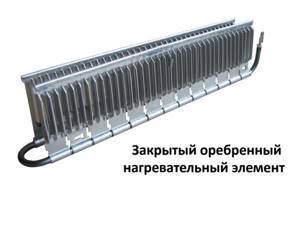
Heating elements in the form of heating elements
Step 5. Select the type of control knob. For a country house and dacha, models with mechanical controls are more suitable, for a city apartment - with an electronic unit. If you have a voltage stabilizer, you can use electronic control in the country.

Remote control for convector
Step 6. Determine the list of necessary functions, as well as the shape of the device, its color and other external characteristics.

Main characteristics of convectors of different models
Note! When choosing, it is also important to take into account the manufacturer, its reputation and the availability of service centers - in case of minor faults, it will be easier for you to find components and parts for repair.
Frame
When choosing a convector, you should also pay attention to the housing.
Firstly, you need to take into account the height of the device; the speed of air movement inside the housing depends on it, which ultimately affects the efficiency of its operation.
A convector with a height of 50 cm is considered optimal. This criterion also applies to floor convectors, but it is not its height that is taken into account, but its width.

Secondly, you need to take into account the thickness of the walls of the housing, because its walls also participate in heat exchange. Therefore, the thicker the walls of the housing, the higher the heat transfer will be, which means the efficiency of the device itself will be higher.
heating elements
Next you should pay attention to the heating elements. Needle-type heating elements, where the spiral is not protected by anything and is fixed on a thin plate, are very fragile; a small blow to the body is enough for the spiral thread to break.
But such convectors are much cheaper than with other types of heaters.
The most reliable and durable are monolithic heating elements. They are not afraid of shocks and can even withstand the device being tipped over. However, the cost of devices with heating elements is much higher.

The choice of monolithic heating elements is also supported by the operation of the convector itself.
Needle-type heaters may crackle slightly during operation, while monolithic heaters are absolutely silent.
Safety
An important factor when choosing a convector is the safety of its operation.
And although such devices are not capable of causing a burn to a person, since the body does not heat up to a traumatic temperature, there is, however, the possibility of accidentally tipping it over.
This is especially true for free-standing convectors.
To eliminate the possibility of a fire from a short circuit if accidentally tipped over, you should purchase devices equipped with a tip-over sensor.
This sensor, if the device overturns, will instantly de-energize it.
You should also take into account the weak level of electrical protection of devices with needle-type heating elements.
Additional functionality
Many convector heaters are equipped with additional functions that can be very useful.
One of these functions is the additional equipment of the device with an ionizer.
In addition to heating, such a device will also purify the air, preventing the spread of pathogenic microbes.
An interesting thing is that the ionizer can work even when the convector does not perform its main function - heating.
But a device equipped with an ionizer can accumulate static electricity, so it requires grounding.
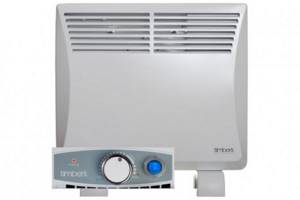
Another useful function is the so-called anti-freeze of the device. This function boils down to the fact that when the temperature in the room drops to a critically low level, for example, to +5 C, the device itself will turn on to increase the temperature in the room.
A very convenient function if you plan to be away from home for a long time.
In programmable convectors, a memory function for temperature settings can often be observed.
This function allows you to save all temperature settings and the device will start working with the specified parameters even after temporarily de-energizing it.
And this is only part of the additional functions that a convector heater can be equipped with.
Electric heating convectors: their capabilities and features
Today, the newest models can be considered truly unique. This is due to their wide functionality and reliability. Among the features is that the body of most products is made of a special alloy that does not heat above 60 degrees. Consequently, ignition of objects around is excluded in the same way as a burn due to accidental touch. Another interesting thing is that you can program convectors. True, not all models have this function; it is inherent in units in the high price range.
Power calculation
Now about one of the most important criteria for choosing a convector heater - its power. After all, this parameter determines whether the device can provide the proper temperature in the room.
When calculating the required power of a device for heating a room, first of all you should decide how the convector will work - as an addition to central heating, or as the main source of heat.
You should also take into account the features of the room itself. In a corner room, or with a large glass area, you will need a device with increased power.
So, to heat a room of 10 square meters. The average value of the convector power is 1 kW. But this indicator is calculated for the average height of the room - 2.5-2.7 m. But this is if the convector is used as the main source of heat.

If it is in addition to centralized or autonomous water heating, then per 10 sq. m. 0.5 kW will be enough.
There is also a universal formula for calculating the power of a convector. Based on it, for every 1 cubic meter. The room should have 35-40 W of device power.
If the room is corner or has a large glass area, then an additional 15-20% of the power should be added to the calculated power of the convector required to heat the room.
Popular with readers: how to install an outlet in the bathroom.
Wiring Requirements
The standard power of convectors, depending on the model, can vary from 0.5 to 3 kW. Electrical wiring and protective equipment in old houses are unable to withstand the maximum power of the device.
In this case, you can focus on the following conditions:
- a convector with a power of up to 2.0 kW can be connected to any standard household electrical wiring with an input circuit breaker rated at least 10 A;
- for a device with a power of 2.0-2.5 kW, electrical wiring with a cross-section of 2.5 mm2 for aluminum or 1.5 mm2 for copper, a 16 A socket and a rating of an input circuit breaker of at least 16 A are required;
- a convector with a power higher than 2.5 kW must be connected with a separate cable with a cross-section of at least 2.5 mm2 copper through a separate circuit breaker with a rating of 16 A.

Floor electric convector
Important! You cannot use extension cords of dubious quality to connect convectors; they often use wires of small cross-section, which can melt under load.

Use only a quality extension cord










